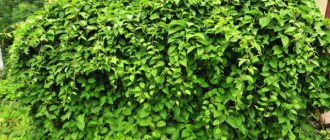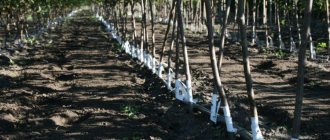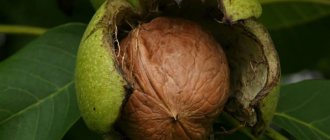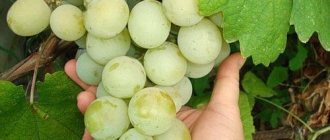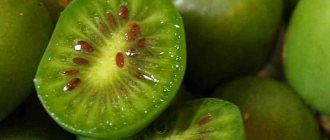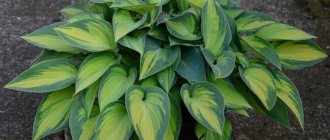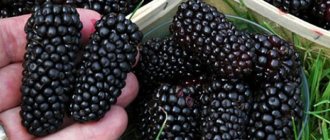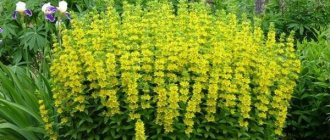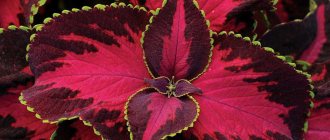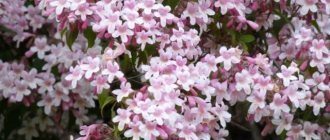Botanical description
Kalmias are evergreen shrubs with glossy elongated or lanceolate foliage, similar to the leaf blades of laurel.
The height of adult plants varies depending on the type and variety and reaches from 60 cm to several meters - 3 or 4.
The flowers are numerous, with a sphenoletal bell-shaped corolla of various colors - white, pinkish or crimson-red - and long stamens.
Kalmia flowers have an interesting method of pollination: in the inner part of the fused petals there are pocket-shaped depressions into which the stamens rest even before the bud opens.
When the flower opens, the stamens are carried away along with the petal, pulling on the filament. If an insect lands on the corolla, the stamen filaments bend under its weight, and the stamen is springily released from the “pocket,” flapping against the insect’s body and showering it with pollen.
Attention! All parts of kalmia contain a large amount of the substance glycoside andromedotoxin. For humans, even the meat of an animal that eats the leaves of a bush turns out to be poisonous.
Choosing a habitat for planting broadleaf kalmia
- Priming. It should be fertile and light, slightly acidic or sour. If it is poor, dig up the area with compost in advance. If it is loam or sandstone, try improving the soil by adding deciduous and coniferous soil, peat (high peat). The soil must also conduct rainwater well. If it begins to stagnate near the roots of the kalmia, the bush will begin to hurt.
- Plot. Partial shade protected from winds and drafts.
Winter hardiness of Kalmiya and preparation for winter
The North American exotic is thermophilic, so the issue of wintering must be approached responsibly. And although manufacturers claim that modern varieties can withstand frosts down to -35 ° C, young bushes can suffer greatly from snowless, frosty winters. To protect the root system from freezing, mulch the tree trunk circle with a layer of peat or humus 10-15 cm thick. The upper part also needs shelter.
Build a tar paper or wooden frame; it is advisable to insulate it inside with polystyrene foam; dwarf bushes can be covered with a wooden box without a bottom. Cover the top with additional spruce branches or non-woven material. Reliable shelter will not only protect from frost and wind, but also from the winter sun, which is also harmful to the plant.
Please note that you should not prepare the cover for the top part too early, since the bushes can dry out, and delay is fraught with freezing. Carefully monitor the air temperature to do everything in a timely manner. With the onset of spring warmth, gradually remove the shelter so that the plant adapts successfully.
Features of growing Kalmia latifolia
If you follow certain rules of care, you can grow this ornamental shrub in your garden, which will decorate your area and delight your eyes with lush flowering. It is not susceptible to disease and rarely suffers from pests, so there will most likely be no problems on this side
But you definitely need to pay attention to watering and preparing the plant for winter.
Kalmiya tolerates short-term drought quite well. But in the dry summer period it is necessary to water it at least once every 2 weeks. About 10 liters of water are poured under each bush. You just need to make sure that the soil has time to dry out. It’s also not a good idea to overwater the plant. Autumn watering is also important when preparing Kalmiya for wintering.
Particular attention should be paid to preparatory measures to protect the bushes from winter cold. You can build something like a house or a box open at the top around the kalmiya
The upper part of it can be covered with spruce branches and fallen leaves. Such shelter will help the ornamental bush survive the winter. This structure will not only protect the plant from frost and cold winds, but also from the winter sun, which can also be destructive for kalmia.
Kalmia broadleaf, like its other varieties, can decorate any suburban area.
It is decorative all year round, both in single plantings and in compositions with other plants, but is especially beautiful in spring, when it is covered with a lush cloud of delicate flowers.
In our country, this ornamental shrub is not found everywhere. And the reason for this is some difficulties in growing and caring for it.
Types and varieties of Kalmia
There are 10 species of shrubs in the genus Kalmia, only a few of which are widely used in ornamental gardening.
Kalmia angustifolia or Sheep Laurel (Kalmia angustifolia)
The most common shrub in cultivation, about 1.5 m high, is very cold-resistant and tolerates temperatures dropping to 40 degrees or more below zero. The leaves are shiny, leathery, lanceolate, dark emerald green.
The flowers are small, up to one and a half centimeters in circumference, grouped into inflorescences-corythes, bloom from June to July.
In species plants, the color of the corollas is pinkish-crimson, but the varieties bred by breeders are distinguished by more diverse flowering:
- Alba (Alba) - with lush snow-white inflorescences;
- Compacta - with delicate cupped flowers of pink or light purple color;
Rubra - with rich dark purple corollas;
Purpurflor - bred from the previous variety and is distinguished by goblet-shaped flowers of a bright purple-scarlet color.
Broad-leaved Kalmia, or Mountain Laurel (Kalmia latifolia) is a tall spreading shrub about 3-5 m tall with large oval-lanceolate leaves. The flowers are snow-white with a slight pinkish tint or soft pinkish, up to 2.5 cm in circumference.
They form dense corymbose inflorescences on the side branches. The bush blooms in May and continues to form buds throughout June. It is poorly resistant to cold winters of temperate latitudes, therefore it is cultivated only in the southern regions of Russia, Ukraine and Crimea.
The most popular varieties of this species:
- Kalmiya Tofka is a very recently bred variety by the German breeder K. Hubbers. Flowers up to 4 cm in diameter, of unusual color - pale pink with a light burgundy pattern in the form of an interrupted ring;
- Kalmia beacon - with red-pink flowers;
- Kalmia latifolia Kaleidoscope Kaleidoscope - with light cherry cups of corollas surrounded by a white border, white coating in the form of a snowflake and a light throat;
Kalmia broadifolia Keepsake - with rich raspberry-burgundy flowers edged with a thin white border.
Kalmia polifolia or Swamp Laurel (Kalmia polifolia) An early flowering species with ascending shoots covered with bluish-emerald foliage.
In April-May it becomes covered with a thick “cap” of bell-shaped flowers collected in apical inflorescences.
Sufficiently frost-resistant species for temperate latitudes.
Kalmia microphylla
A compact shrub, not exceeding 1 m in height, with leathery dark green lanceolate leaves, the edges of which curl downwards.
The flowers are small, purple or pink in color, collected in a few racemes, open in May-June.
Kalmia buxifolia
Representatives of this species have a very variable appearance.
They are completely dwarf, no more than 10 cm tall, or grow up to 1 m.
Their leaves can have an oval or lanceolate shape, located on the pagons alternately or oppositely.
Pale pink or snow-white flowers form an umbrella or racemose inflorescence.
Some species of Kalmia are today classified in other genera, for example, Kalmia procumbens is classified in the monotypic genus Loiseleuria, and its correct botanical name is Loiseleuria procumbens.
Name
Per Kalm
The scientific name of the genus is derived from the surname of Per Kalm (1716-1779) - a Swedish (Finnish) botanist, professor at the Royal Academy of Abo (Turku), student of Carl Linnaeus. Kalm was one of the Apostles of Linnaeus, participated in an expedition to North America (1747-1751), and later, returning to his homeland, grew some North American plant species, including Kalmia angustifolia
)[3], which at that time was attributed to the genus
Chamaedaphne
.
In 1753, in his work Species plantarum,
Linnaeus identified a new genus
Kalmia
, naming it after his student[4];
in this genus Linnaeus included Kalmia angustifolia and Kalmia latifolia
.
Occasionally in the literature, another Russian name of the genus is found - Kalmia
[5].
Varieties of Kalmia
Of the eight species, garden plants include the following:
- Kalmia angustifolia tolerates frosts. Blooms with white, pink or crimson flowers. The height of the plant can be 40 centimeters, and sometimes reaches one and a half meters. The subspecies Rubra and Alba are considered popular. The shrub blooms in mid-June, and pleases with its flowering for a whole month;
- Kalmia multifolia blooms in early summer and blooms for three weeks. Grows up to one meter. Grown in all areas of the Middle Zone. Blooms with purple-pink flowers;
- Kalmia broadifolia is considered the largest-flowered, abundantly flowering, tall shrub. Its height can reach three meters. The leaves of the plant are constantly green and resemble laurel foliage in appearance. They are elliptical-lanceolate, green, and slightly yellowish below. Pink flowers look harmonious with dark-colored anthers. Before the flowers bloom, the stamens are located in pits at the base. The bush blooms at the end of May. The flowers are collected in corymbose inflorescences that cover its entire crown. After flowering, a round box of seeds is formed, which can be collected for propagation of the plant.
There is also a bush called Kalmia boxifolia, which grows no higher than one meter. It is dotted with small leaves and flowers.
Kalmiya - planting, care, description and varieties with photos
Broadleaf Kalmia (Kalmia latifolia) is a member of the Kalmia genus, which includes about 10 species of evergreen flowering shrubs from the Heather family.
The genus name is given in honor of Per Kalm (1715-1779), a Finnish student of Linnaeus, botanist and naturalist. Broadleaf Kalmia is a popular and easy-to-care garden shrub whose decorative value includes beautiful evergreen leaves and magnificent flowers. In Europe, the plant has been cultivated since the 18th century.
This species grows naturally on rocky slopes and montane forests in eastern North America, where it is called mountain laurel.
Planting Kalmia in open ground
Planting and caring for kalmia does not require special knowledge or skills; it is enough to understand some of the preferences of the plant in order to plant it correctly and avoid mistakes in care.
Site selection
Kalmia does not like bright sunlight; it will only tolerate a few morning hours in direct sunlight.
The rest of the day, openwork partial shade under the sparse crown of deciduous or coniferous trees is desirable.
Even in winter, the bush reacts painfully to bright sunlight.
Less frost-resistant species and varieties need protection from cold winter winds, so a secluded corner in the garden is chosen for them, not in a draft.
Suitable soil
Like many heathers, Kalmia grows on acidic soils and does not accept the presence of lime in the soil, as well as the use of crushed limestone as drainage.
Shrubs develop poorly in soil with a high chlorine content.
Before planting kalmia, sandy or clay soil must be improved by adding peat or leaf humus.
However, growing the plant in purely heather or peat soil is also undesirable, since such soil reduces the bush’s resistance to diseases and “pampers” it.
The Kalmia plant tolerates moderately moist soil well, but does not tolerate stagnant moisture, and in an area with groundwater close to the surface of the earth, drainage ditches will be needed.
How to plant correctly
In the spring, holes are dug in the selected bed at a distance of 0.8-1.5 m between the bushes - depending on whether they are planted in a dense or loose group.
The size of the holes is approximately 50x50 for two- or three-year-old seedlings.
Their depth is commensurate with the length of the root system, usually no more than 50-60 cm.
A drainage of sand or broken brick is laid at the bottom in a layer of 15-20 cm, a mixture of leaf soil, pine needles, high peat and sand in a ratio of 2:1:3:1 is poured on top and 50-60 g of mineral fertilizers are added.
The plant is placed in a hole so that its root collar is at soil level.
Sprinkle the roots, lightly tamp and water. The area around the trunk is mulched with small wood chips or peat.
Growing Kalmia from seeds
Kalmia seeds
Kalmiya is grown from seeds by seedling method. Seeds are purchased at specialized sales points, but they are quite rare. If, by luck, someone you know has a magnificent kalmia growing on their property, collect the seeds yourself.
Dry the seeds, place them in a paper envelope or fabric bag, and store them in a cool, dry place. You should start sowing in March, but the seed needs pre-treatment. 2-2.5 months before sowing, remove the seeds from a secluded storage place and send them to the refrigerator for stratification.
Kalmia seedlings photo
- For sowing, you will need containers with loose, nutritious, acidic soil (a mixture of peat and sand is suitable).
- Distribute the seeds over the surface of the soil, irrigate with a fine spray, and cover with oilcloth or transparent glass on top to maintain the greenhouse effect.
- Lighting will need bright, diffuse lighting; maintain the air temperature within 22-25 °C.
- Seeds germinate within 3-4 weeks, do not forget to lift the shelter daily for ventilation, and periodically spray the soil surface.
- Once the sprouts appear, you can remove the shelter and thin out the dense shoots.
- At the stage of appearance of 3-4 true leaves, plant the seedlings in separate pots.
- Further care consists of moderate watering.
Ideally, seedlings are grown in pots for 2 years, and transplanted into open ground in spring or autumn.
Plant care
Growing Kalmia will require a lot of effort; the plant is demanding in terms of soil composition, watering and lighting. If all conditions are met, the gardener can expect a beautiful, densely flowering shrub.
Selecting a location
A semi-shaded area of the garden, protected from direct sunlight and cold drafts, would be an excellent place for the bush. If representatives of the Heather family are already growing on the site, then proximity to them will only benefit the plant. If there are no places with light fertile soil, then the future site is fertilized in advance with peat, compost, and leafy soil and sand are added.
Kalmia latifolia Galaxy
Trimming
Due to its slow growth, the shrub reaches its standard size only by 8-10 years. As the branches grow, they form a neat crown that does not require formative pruning, although the bush tolerates it calmly. However, you should pay attention to the appearance of the bush, promptly remove dead old branches and faded buds.
The soil
Prefers dry, loose, sandy, highly acidic, well-fertilized and drained soils. The distance between neighboring bushes should be at least 80 cm.
Top dressing
If a young seedling is planted in a properly selected, fertilized place, the next feeding is necessary after 2-3 years. Adult plants are fertilized once in April-June; a complex mineral fertilizer is chosen specifically for rhododendrons. Organic fertilizers are also suitable: in the spring, add a solution of urea, during flowering, a solution of chicken droppings or mullein.
As soon as the plant needs additional nutrient medium, the lower part of the leaf blade begins to turn pale. You should notice changes in the color of the lower part of the leaf in time and apply fertilizing, since this moment can be missed due to the fact that the back side of the leaf has a light shade.
Kalmia latifolia 'Kaleidoscope'
Watering and loosening the soil
The moisture-loving plant requires periodic watering, but it does not tolerate stagnation and excess moisture. Watering time is determined as the top layer of soil near the trunk dries. Additional spraying of the crown will have a beneficial effect on the condition of the plant. Water the bush in the morning or evening 2-3 times a week. Young plants need up to 3 liters at a time, adults 8-10 liters. After each watering, it is necessary to loosen the soil around the trunk and remove weeds.
Wintering
Many adapted varieties in the temperate zone of Russia are easy to grow in open ground. However, before frost, the plant needs additional protection, especially for young shrubs. In the fall, after flowering, the plant is watered abundantly and the soil near the trunk is sprinkled with peat or humus with a layer of up to 15 cm. The plant requires complete shelter for the winter. If the shrub is small, it is covered with a wooden box without a bottom and covered with covering material. For taller bushes, insulated wooden frames are used. The time of shelter must be chosen precisely; you cannot wrap up the bush in advance, it may dry out, and belated actions will not save you, the plant may freeze. In spring, the plant is opened gradually so that it gets used to the change in temperature.
Kalmia latifolia Sterntaler
Diseases and pests
The plant is resistant to pest attacks and is not susceptible to various diseases.
Reproduction
These types of Kalmia reproduce in two ways: using seeds and by separating the roots from the main plant. When choosing the appropriate option, you should consider your capabilities.
One of the simple methods of breeding Kalmia is the use of root shoots. To do this, the offspring are planted in containers, where they develop for 3 years. When the plant turns into a full-fledged seedling, it is transferred to the garden plot. There it takes its honorable permanent place, where it will serve as a decoration for the front garden for many years.
To grow Kalmiya from seeds, you should collect planting material in time. The most suitable period is mid-autumn. After collecting the seeds, they must be dried and stored in a dry place.
For better germination, the seeds are kept in the cold for about 2.5 months, and only then sown.
Kalmiyas sown in special containers will sprout after 30 days. They grow very slowly at first, but with patience we will be rewarded. When they grow to 4 cm, the seedlings can be pricked if necessary.
After 2 years, the seedlings begin to be fed with mineral fertilizers. Thanks to this, they will begin to grow faster. When young Kalmias begin to branch, it is better to transplant them into new containers, where they will remain until they are 5 years old. Then the seedlings are planted in a permanent place in the garden. And then they will become the gentle charm of a summer cottage in the Moscow region.
Reproduction of Kalmia
Gardeners experience certain problems when choosing a method for propagating shrubs.
The seed method is lengthy and troublesome, and of the vegetative methods, the simplest is root shoots; the rest are a rather labor-intensive process due to the slow development of the plant.
Seeds
Around October, in some regions - in November, Kalmia seeds ripen in brown, five-locular, pubescent capsules.
They are removed, cleaned and stored in a closed container, which is placed in a cool, dry place where the temperature is maintained at 4 degrees Celsius.
By the end of December, the seeds are taken out and sown in containers filled with sphagnum peat mixed on the surface with river sand.
Containers with crops are covered with a net on top and taken out into the garden so that the seeds undergo natural stratification under the influence of low temperatures.
With the arrival of March, containers with crops are transferred to a greenhouse, covered with polyethylene and their daytime temperature is maintained at about 18-24 degrees above zero, and the night temperature is allowed below - 8-10 degrees Celsius.
From the moment the containers are brought into the greenhouse and after 3-4 weeks, Kalmia seedlings begin to hatch - approximately 90% of the total number of seeds sown.
Seedlings develop very slowly: at one year of age, the height of the sprouts often reaches only 3 cm.
Some of them are planted in separate pots, some grow further in the same containers.
Practice shows that picked seedlings slow down their growth, and those remaining in containers begin to branch. At this age, they can be fed with potassium humate leaf by leaf.
All 4-year-old seedlings are planted in separate containers filled with a mixture of peat, sand and pine compost, taken in a ratio of 2:1:1.
Kalmia seedlings grown from seeds bloom for the first time at 5 or 6 years of age, and are transplanted into open ground at 6-7 years of age.
Cuttings
Kalmia cuttings give a low percentage of rooting. However, recently, with the help of root formation stimulants, gardeners have managed to achieve a positive result in 75% of the total number of rooted cuttings.
The shoots are cut from semi-lignified pagons in early July. The cut is treated with 0.2% alpha-naphthylacetic acid with the addition of talc and foundation, then rooted in a greenhouse, buried in boxes filled with a mixture of peat, sand and pine bedding in a ratio of 3:1:1. Cover the top with plastic wrap. Roots appear after 3-4 months.
Treatment of cuttings with root gives the worst result - the cuttings do not die, remain in the soil mixture for a long time without changing their appearance, but callus is formed only after a year, and full-fledged roots appear only in the second year of rooting.
Layerings and root shoots
The best propagation results are obtained by separating the root shoots in the spring. Young plants are carefully cut off from the mother root, the wounds are sprinkled with crushed charcoal and planted in separate holes in a garden bed.
Layers that are inclined toward the soil and sprinkled with soil in the fall or spring take root relatively well. There is no rush to separate it from the mother plant until it has grown a viable root system.
Usually the cuttings are transplanted into an individual hole for the 2nd or 3rd season.
Transplantation and propagation
Experienced gardeners recommend planting kalmia in open ground in the spring, having previously prepared the planting site.
Step-by-step landing instructions
To grow kalmia in the fall, before frost, prepare the soil for spring planting of seedlings. To do this, the soil is dug up and a complex of mineral fertilizers is added to the ground. If the purchased seedling has an open root system, then to prevent the roots from drying out, put it in water for 1-2 days. For better adaptation in the soil, a solution is added to the water to stimulate root formation.
If the weather is warm enough in the spring, when the soil has already warmed up, prepare a planting site for the seedling: a hole 40-50 cm deep and 60 cm in diameter. A drainage layer of any suitable material, except crushed limestone, is poured into the bottom of the hole. Next, almost half is filled with fertile soil. For 7-10 days, the pit is covered with a lid or film to create the necessary microflora. Afterwards the seedling is inserted into the hole. If the young plant is in a flower pot, it is carefully removed by transferring it, preserving the earthen lump. The pit is watered until the soil stops absorbing water. The roots of the plant are covered with earth, compacted, and all the soil near the trunk is densely sprinkled with spruce needles or peat.
One of the main conditions when caring for and planting Kalmiya is that the root collar must be level with the soil level, otherwise the plant is in danger of drying out or rotting the roots from stagnant water.
Kalmia latifolia Pinwheel
Transfer
Kalmiya reacts very painfully to transplants. Experienced gardeners recommend thinking carefully about where to plant the bush as a permanent one. But if, nevertheless, there is a need to change the “place of residence” of Kalmiya, then a new place is prepared in the same way as for a young seedling.
Reproduction methods
Kalmiya is propagated by seed and vegetative methods (cuttings, layering).
The seed method requires a lot of time. Ripe dried seeds are placed in a container on fertile soil at the end of December. The container is left in a room with good lighting, possibly on the balcony. The soil in the container should not dry out. With the onset of spring, the container with soil is covered with polyethylene and moved to a greenhouse or warm room with high humidity. After 25-30 days, seedlings will appear, the growth rate of which is very low, no more than 3-5 cm per year. When propagated by seed, the first flowers bloom after 5-6 years; for transplanting into open ground, they will be ready by the age of seven.
When propagating vegetatively in the summer, cuttings are prepared and kept in a solution of a root formation stimulator for 24 hours. Place in a greenhouse in a separate container, lightly compact the soil, and cover with a transparent cap. The condition for root formation is to provide high humidity and light for more than 12 hours a day. After 3-4 months, the cuttings take root. Depending on conditions, rooting time can take up to 1 year. It should be remembered that only half of the cuttings take root in the soil.
Spreading
In the natural environment, all representatives of the Kalmia species are found in North America; they are observed even in the northern regions of Alaska. They grow in forests, on forest edges, along the banks of rivers and reservoirs, and in wetlands.
Plant root stimulants
In specialized gardening stores you can purchase ready-made solutions of plant root formation stimulants: “Kornevin” or “Ecosil”. However, no less effective are natural stimulants prepared independently at home, which, unlike store-bought ones, do not contain chemicals or harmful substances.
One of the most effective stimulants is an infusion of willow branches, which is used both for watering seedlings and soaking seeds, and for aging cuttings.
A potato tuber is an excellent root growth stimulator: cuttings are inserted into half of the tuber and left for several days. This way the cutting will not dry out and will receive a sufficient amount of nutrients. Aloe juice, like yeast, serves as an excellent root formation stimulator. Water with honey is no less effective.
Kalmia latifolia Peppermint
Description, types and varieties
Kalmia is an ornamental evergreen shrub that belongs to the Heather family. The birthplace of this plant is North America, but today it is successfully used in landscape design in many countries. About ten species of this shrub are known. But for decorative purposes, only three of the varieties of Kalmia are most often grown:
- broadleaf;
- narrow-leaved;
- multileaf.
Broadleaf Kalmia is one of the most spectacular varieties. The height of the shrub can reach from 0.8-1 m and up to 2.5-3 m under favorable conditions. The crown is spreading. The leaves are lanceolate, dark green. Kalmia usually blooms in late spring. But it can bloom in early summer. The flowers are delicate, in various shades of pink. Then, in place of the inflorescences, boxes with small seeds are formed, which fully ripen in the fall.
Kalmia flowering
There are different varieties of Kalmia latifolia, and the most beautiful of them are “Elf”, “Little Linda”, “Olympic Flame”, “Midnight”. It takes root better and grows well only in the southern regions of the country. In the middle zone, it is also planted in open ground, but in cold winters it may freeze out and not recover after that.
Helpful advice! In the conditions of the middle zone, tender kalmia will definitely need shelter for protection from frost and cold winds for the winter.
Description of Kalmia latifolia
Kalmia, which belongs to the Heather family, is native to North America. In the middle of the 18th century, the Swedish naturalist Per Kalma tried to cultivate this plant in European countries. In honor of him, the bush got its name - Kalmia. Today this plant can be seen in the gardens of England, Italy, Germany, Austria, southern Poland, and the Czech Republic. The genus of this plant includes 8 species, one of which is Kalmia latifolia.
The Kalmia broadleaf bush is spreading, quite tall (about 3 meters). It grows slowly, growing only 2 cm of branches per year. In the initial phases of plant development, the shoots are thin but elastic. The bark initially has a purple tint, but as it ages it becomes gray-brown and woody.
The leaves of the shrub are similar in appearance to laurel leaves: they have a lanceolate-elliptical shape, the length of each leaf reaches 5-10 cm. The leaves have a dark green tint on top and yellowish below.
The flowers give the plant special beauty - pale pink, saucer-shaped, with ten dark anthers. In the bud stage, the stamens are located in dimples at the base of the flower. The flowers are small, they are 2-2.5 cm in diameter.
Kalmia latifolia flowers have an interesting adaptation to cross-pollination. The flower is designed in such a way that the thin stamen filaments are arched, and the anthers rest against the protrusions on the petals in the form of pockets. When the bud opens or when it is lightly touched, the filaments of the stamens quickly straighten, and the mature anthers eject pollen through the apical opening of the nests.
The flowers of the plant are collected in corymbose inflorescences, which are located at the tops of the shoots. One inflorescence can contain about 250 flowers. In the southern regions, the shrub begins to bloom from mid-May and throughout June. When flowering ends, round, woody boxes appear on the bush, in which the seeds begin to ripen. Under favorable weather conditions, the seeds fully ripen by the end of October - November.
Kalmia care
Kalmias do not require the gardener’s increased attention and vigilant monitoring.
Several times during the growing season, the soil around the plants is loosened, but very carefully - their root system is superficial and can easily be damaged with a sharp hoe.
Watering and fertilizers
The Kalmiya bush is quite drought-resistant and will not suffer much in hot weather in summer, as long as it is not exposed to direct sunlight.
However, watering twice a month during a long absence of rain is responded with gratitude.
Up to 10 liters of water are poured under each adult bush.
Fertilize the plant two or three times from early April to mid-June.
In the spring, urea is added at a rate of 35 g per bucket of water, and during the intensive growing season it is fed with organic matter.
In autumn, any granular universal fertilizer for ornamental garden plants is scattered under the bushes.
Does Kalmia need pruning?
The plant develops very slowly and has a neat crown, so it does not need formative pruning.
In the spring, sanitary pruning is carried out - the bush is carefully inspected and dry and damaged branches are removed.
After flowering, faded inflorescences are removed from shrubs not intended for collecting seeds.
Preparing for winter
Frost-resistant species and varieties do not need shelter for the winter.
Less resistant ones will suffer from freezing, so they are hilled up and covered with fallen dry leaves, spruce branches or lutrasil.
In the spring, they try to remove the cover early and rake the leaves away from the root collar, otherwise it will become damp and begin to rot.
How to decorate your garden with kalmia
Living in the Moscow region, you can afford the following varieties: Bando, Black Label, Eva, Carousel, Elf. Such bushes can withstand winters down to -35 degrees. True, in the first years they will have to be insulated for the winter.
When choosing a seedling, discard broken or diseased specimens (with circles of mold on the roots or stem or spots of unknown origin). A good plant should have an even and smooth trunk, several woody branches up to 20 cm in length, and succulent roots. Ideally, the seedling will be sold in a container.
In open ground, a two-year-old plant will take root better.
Description of the plant
Kalmia is an evergreen shrub of the Heather family. The height of different types can vary from 50 cm to 2.5 m.
The leaves are dense, leathery, lanceolate in shape with a pointed end, from 2 to 15 cm in length, arranged spirally along the stem or opposite, shaped like laurel leaves. The lower part of the Kalmia leaf is grayish-gray with a light coating, the upper part is smooth and green. Every two years the plant changes foliage: the old one turns brown and falls off.
The inflorescences are numerous, dense, funnel-shaped, bell-shaped or cup-shaped flowers up to 1-3 cm in diameter, pink, red or white, with long stamens.
When describing Kalmia, special attention is paid to the interesting structure of the bud: the long stamen is in a state of “readiness” near the petals; as soon as an insect lands on the flower, the stamen jumps out and sprinkles it with pollen. This is how cross-pollination occurs. The buds bloom in late spring - early summer. In autumn the fruit ripens in the form of a small capsule with multiple seeds.
Popular types of charming shrubs
The genus of evergreen Kalmia has about 8 species, which are widely known in America and Europe. Of these, only a few have taken root well in Russia. For many summer residents in the Moscow region, kalmia has become a favorite decorative garden decoration.
Kalmia angustifolia
This type of shrub grows up to 1.5 m in height. Dwarf varieties that grow up to 40 cm are also known.
The leaves of the plant are lanceolate, oblong, about 6 cm long. The upper part is green, and the lower part has a bluish tint.
Kalmia angustifolia is distinguished by its amazing cup-shaped inflorescences. Almost always they are pink, and only occasionally white. The buds are collected in umbrella-shaped inflorescences. Each bud reaches approximately 1 cm in diameter. In general, the inflorescences have a gorgeous appearance, especially when they bloom at the same time. Therefore, we can safely say that kalmia is a real natural masterpiece in a summer cottage.
Read also: Review of the egg incubator “Universal 45”
The decorative narrow-leaved shrub variety began to be bred since 1736 outside of Russia. Only a century later, the evergreen shrub was brought to Moscow. Since 1988, the plant has been growing in the Botanical Garden. There it blooms every year and pleases the eye for a whole month.
Kalmia multifolia
This variety of evergreen plant is distinguished by a compact crown, raised upward. The original lanceolate leaves of Kalmia multifolia are painted in a dark blue-green color.
Buds appear on shoots in late April or early May. In shape they resemble miniature bells, which are collected in delightful bouquets. The flowers are painted pink, which looks original against the background of green leaves.
Diseases and pests
The plant is considered resistant to most diseases of garden crops. However, in rainy summers under conditions of high humidity and high temperature, Kalmiya is susceptible to fungal infections that affect the root collar, runners, leaves and peduncles of the bush.
If the disease is mild, the affected parts of the plant are removed and burned, and the entire bush is treated with one of the fungicides, for example, topaz or benlate.
In addition, overgrown dense shrubs are tied up in order to lift the branches higher and provide air access to the root collar and internal crown moldings.
Sometimes signs of chlorosis are observed on the leaves of Kalmia - lightened spots on the leaf blades, leading to a gradual yellowing of the entire leaf, with the exception of the veins.
It is recommended to add iron chelate or sulfate to the soil, following the instructions included with the package.
Pests have hardly been noticed on Kalmiya, and the shrub is considered to be resistant to attack by insects and mites.
However, some sources mention rare isolated cases of the presence of scale insect colonies on Kalmia pagons.
Planting Kalmia
For replanting, you need to choose a suitable unshaded place on the site.
Soil requirements
In this regard, Kalmia has similar preferences to rhododendrons and grows most successfully on neutral soils. Despite the fact that the presence of peat in the soil makes it light and breathable, too much of it “pampers” the crop, making it less resistant to adverse environmental factors in the future. The same can be said about heather soils. The soil in its optimal quality should be composed of peat with the addition of leaf soil, coniferous litter or the bark of coniferous plants with the addition of some sand (ratio 3: 2: 1: 1). If you add a balanced complex of mineral fertilizers to this composition (about 60 g per planting hole), the plant will suffer less in the future.
Landing scheme and rules
The planting scheme should take into account the density of the natural soil. If the soil is loose, the distance between future plants should not be less than one and a half meters. Rough, dense soil will not allow the bushes to grow much over time, so they can be brought closer together to 0.8 m. To plant a 3-year-old seedling, a planting hole measuring 50x50 cm with a slightly deeper depth for arranging a drainage layer is sufficient. Considering that Kalmia really does not like waterlogging, when planting it you should not forget about classic drainage, for example, from sand mixed with broken brick, which is poured in a layer of 20-30 cm to the very bottom of the planting hole.
Important! After shrinkage of the planting soil, the root collar should not fall below its level.
Caring for the seedling after planting
Caring for a newly planted kalmia will require more attention than caring for an adult plant. The poorly developed root system of a young seedling, already located in the upper layers of the soil, is very sensitive to drying out of the soil. Regular watering is required, followed by very careful loosening. Instead of loosening the soil, it can be mulched with peat, sawdust or any other suitable material. The bark of coniferous trees or the pine needles themselves are very suitable as mulch for Kalmiya.
Top dressing
Feeding is carried out 2-3 times per season. The first time in early spring, when active plant growth begins, urea is added at the rate of 30 g per 8 liters of water. Then use slurry, carefully diluted in a ratio of 1:15, so as not to burn the roots. The Kemir-universal complex has proven itself well as an autumn fertilizer. It can be sprinkled directly on the ground at the rate of 100 g for each plant.
Watering
After Kalmia has taken root well in its new location, watering can be reduced somewhat. Fertilizers are not canceled so as not to lose the decorative appearance of the plant, but they reduce the content of the nitrogen component in it, giving preference to potassium and phosphorus. In the fall, rotted organic matter should be added to the soil.
Planting and care
In Russia, this plant grows well only in zones 5 and 4. When in the latter, you will need winter shelter, since the plant must be protected from sunlight and cold wind. Capable of growing in full sun, but prefers partial shade. For planting you will need non-acidic soil; it is additionally recommended to use a drainage system.
The mixture used should consist of sand, pine needles, peat and leaf soil. You can use mineral fertilizers, but not more than 50 g per hole. A plant with a closed root system can be planted on any warm day, but it is preferable to do this in the spring. The planting hole should have dimensions of 50x50x50 cm. The drainage is placed at the bottom of the hole and is made of sand, broken brick or fine-grained expanded clay. The distance between the holes must be at least a meter. When planting, the level of the soil and the root collar must be the same.
Like rhododendron, this type of plant tolerates drought well, but will not tolerate heavy watering. Watering should be done every few weeks, but remain moderate.
Before this, the soil is carefully loosened, since the root system is on the surface. In autumn, watering is also necessary to ensure that Kalmia survives the winter well.
It is recommended to use fertilizers no more than three times a year. To make the solution you will need urea. Dry fertilizers are scattered around the bush. Regular mulching is required to help avoid possible overheating of the roots. It is extremely resistant to pests and diseases.
Main types and varieties:
- narrow-leaved Kalmia "Rubra". Used as an ornamental plant;
- narrow-leaved "Compacta". The inflorescences have a rich purple color;
- narrow-leaved "Alba". Its inflorescences are white;
- Kalmia latifolia.
Reproduction
When using seeds, the following procedure is carried out:
- collection takes place at the end of October. They are cleaned and placed in a pre-prepared container. Contained at a humidity of 5% and a temperature of about 4*C;
- Seeds are sown in containers in early December. They are first filled with river sand and peat;
- containers are covered with a net and stored outdoors. This will serve as a kind of stratification;
- The boxes are placed in the greenhouse in March. They are covered with film and kept at a temperature of 19 to 26 degrees Celsius;
- The first shoots should appear within three weeks. Their similarity percentage is good and amounts to more than 90%;
- Over the course of a year, they can grow several centimeters, after which they can be planted. To accelerate growth, you can spray potassium humate with potassium humate;
- in the fourth year they can be planted in deep containers. A mixture containing sand, compost and peat is used as soil;
- in the sixth year of life the plant may bloom for the first time;
- and at the age of seven years it can be transplanted into open ground.
All fertilizers must be applied very carefully around the perimeter of the plant. In the first years of a young bush’s life, it is recommended to use nitrophoska. You will need no more than a gram of this fertilizer per liter of water. After transplanting into larger containers, bait is carried out three times, every two weeks. To propagate Kalmia using cuttings, they must be harvested in the summer. Previously, they are treated with a solution based on a growth stimulator. After which they are planted in a greenhouse and wrapped in plastic film.
Humidity levels play an important role in their development process. After five months, the first roots should appear. Only after this can they be planted in a permanent place. Low-lying branches are used to make layering. They are carefully bent and buried in the ground.
For the speedy development of the root system, they need to be watered regularly.
After the roots appear, the cuttings are carefully separated and transplanted into a previously prepared hole. Root shoots, as well as a dug up and transplanted bush, should be looked after
The first sanitary pruning is carried out in the spring, when frozen or dried branches are detected.
Welcome!
When planting Kalmia, I was guided by its relatives - rhododendrons. I found a shaded place where the sun only shines early in the morning. I dug a planting hole and placed broken bricks at the bottom as drainage. Then I prepared a soil mixture consisting of high-moor peat, pine litter, leaf soil and sand, adding to it a little expanded clay for looseness and a handful of fertilizer specially designed for rhododendrons. After filling the hole, I left it for a week to allow the soil to settle. Before planting, I carefully pulled the kalmia bush out of the pot and soaked the root system in a solution of a root formation stimulator for several hours. After that, I quite easily “gutted” the dense lump and, having distributed the roots in the hole at a shallow depth, covered them with the remainder of the mixture and mulched them with the same fallen pine needles.
| Expert comment: |
Article on the topic: How to properly plant a lawn at your dacha
The summer in the year of planting my kalmia turned out to be dry. Evergreens, especially rhododendrons, were simply sweltering from the heat. The “new girl” got it too. Of course, a thick layer of pine needles helped keep the soil in the tree trunk moist, but the air remained very dry. In addition to frequent watering, I regularly sprayed the Kalmiya and even organized additional shading for it.
By autumn, my 'Gnome' had finally settled into its new place, and on the eve of winter the question of shelter arose. Since I am firmly convinced that in the first year after planting, young plants that may suffer from frost must be covered, all that remained was to decide which option would be preferable. The choice was determined by the small height of this Kalmia variety. As a frame, I used an old wooden box without a bottom, laid two branches of spruce branches crosswise on top so that the bush would not be broken by snow, and covered the entire structure with burlap.
| Expert comment: |
My efforts were rewarded handsomely. Kalmiya, it seemed, did not even notice the winter and in the spring, as if nothing had happened, began to grow. Holding my breath, I looked at the numerous tiny balls of buds, fearing that some cataclysm would interfere with the plans of the 'Gnome' and deprive both of us - both me and him - of flowering. But fate turned out to be merciful, and at the end of June the bush, as expected, was covered with a scattering of small but charming flowers. Vivat, Kalmiya!
| Expert comment: Before the start of winter, Kalmia needs to be covered. To do this, you can use various materials, for example, spruce branches or matting, burlap or “non-fabric”, which are pulled over a frame prepared in advance. In autumn, the plant should be mulched to protect the root system from damage due to soil freezing. Late spring and early autumn frosts can also cause damage to young shoots, so it is advisable to provide protection for this period as well. |
